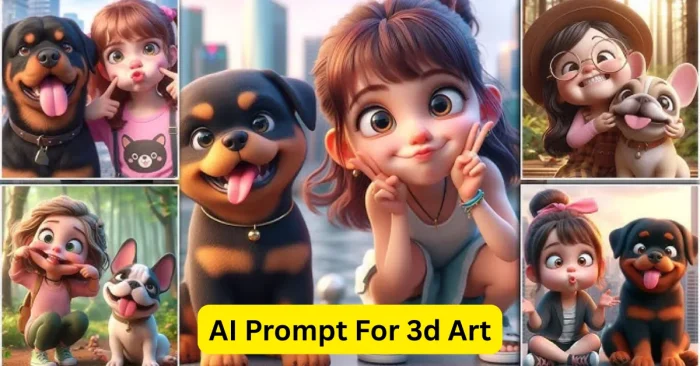Introduction to AI Prompt for 3D Art Tools
AI Prompt for 3D Art tools are advanced platforms that allow users to generate realistic or stylized three-dimensional artwork from text descriptions. These tools leverage AI models, including generative adversarial networks (GANs) and neural rendering algorithms, to create 3D objects, scenes, characters, and environments. Artists, game developers, animators, and content creators use these tools to visualize complex 3D concepts quickly without manually modeling or rendering. By providing descriptive prompts specifying shapes, textures, lighting, perspective, and style, users can produce high-quality 3D visuals efficiently, saving time and enhancing creativity.
How AI Prompt for 3D Art Works
AI 3D art generators process text prompts and use trained models to create three-dimensional images or renderings. Users input detailed descriptions of objects, characters, scenes, lighting, colors, and textures. The AI interprets these inputs and generates multiple 3D outputs, often allowing customization of angles, depth, and style. These platforms may also integrate with rendering software to produce high-resolution, realistic visuals suitable for games, animations, virtual reality, or concept art. Users can refine outputs, combine multiple designs, and export final renders in various formats for professional use.
Key Features of AI Prompt for 3D Art Tools
Text-to-3D Art Generation
Generate realistic or stylized 3D objects and environments directly from descriptive text prompts.
Multiple Design Variations
Create several 3D renderings per prompt, offering options to select the best output or combine elements creatively.
Customizable Style and Perspective
Adjust lighting, textures, angles, and artistic style to achieve desired 3D effects and realism.
High-Resolution Export
Export 3D images and renders in high-resolution formats suitable for animation, gaming, VR, and digital media.
User-Friendly Interface
Platforms provide intuitive navigation, making 3D art generation accessible for beginners and professionals alike.
Top AI Tools for 3D Art
Some of the best AI tools for generating 3D art include:
- Daz 3D AI – Offers AI-assisted 3D character modeling and scene generation with realistic rendering.
- Blender with AI Add-ons – Enables AI-driven generation and refinement of 3D objects and animations.
- Runway ML – Provides AI-based 3D generation and editing tools for professional designers.
- NVIDIA Omniverse – AI-powered platform for creating realistic 3D simulations and virtual environments.
- DreamFusion – Converts text prompts into 3D models and environments using neural rendering techniques.
- Kaedim AI – AI tool for generating 3D assets from 2D sketches or text prompts for game and animation use.
Examples of Effective 3D Art Prompts
Here are some sample prompts for generating AI 3D art:
- “A futuristic 3D cityscape with neon lights, flying vehicles, and reflective glass buildings.”
- “A detailed 3D fantasy dragon perched on a mountain peak with dramatic clouds.”
- “A stylized 3D character in medieval armor holding a glowing sword, cinematic lighting.”
- “A 3D interior of a modern living room with wooden textures, natural sunlight, and minimalist design.”
- “A sci-fi spaceship in orbit around a colorful alien planet, highly detailed 3D render.”
- “A realistic 3D forest scene with fog, mossy trees, and a sparkling river.”
- “A whimsical 3D creature with large expressive eyes in a magical fantasy setting.”
Benefits of Using AI Prompt for 3D Art Tools
AI 3D art tools significantly reduce the time and effort required for modeling and rendering. They enable rapid visualization of ideas, supporting experimentation with textures, lighting, and perspectives. Multiple design variations increase creative flexibility, and high-resolution outputs ensure professional usability across digital media, games, animations, or virtual reality. These tools empower artists, designers, and developers to produce professional-quality 3D assets efficiently and creatively, without needing advanced modeling skills or expensive software.
Workflow Tips for Using AI Prompt for 3D Art Tools
Provide Detailed Prompts
Include information about shapes, textures, lighting, perspective, and style for better 3D output accuracy.
Experiment with Variations
Generate multiple 3D outputs to explore different angles, designs, and lighting effects before finalizing.
Refine and Customize
Use platform tools or additional software to adjust textures, depth, and composition for polished renders.
Combine Multiple Outputs
Merge different generated models or elements to create unique scenes or characters.
Export in High Resolution
Save images or 3D models in high-quality formats for professional projects, animations, or VR applications.
Frequently Asked Questions (FAQs)
What are AI Prompt tools for 3D art?
They are AI-powered platforms that generate 3D models, characters, environments, and scenes from text descriptions.
Do I need 3D modeling skills to use these tools?
No, AI 3D art generators are user-friendly and allow anyone to create professional-quality 3D visuals from text prompts.
Can AI-generated 3D art be used commercially?
Yes, but licensing and usage rights vary by platform; always review terms before commercial application.
How can I improve the quality of AI-generated 3D art?
Provide detailed prompts, refine outputs, experiment with multiple variations, and export in high-resolution formats for the best results.
Which AI tools are best for generating 3D art?
Popular tools include Daz 3D AI, Blender with AI Add-ons, Runway ML, NVIDIA Omniverse, DreamFusion, and Kaedim AI.
















